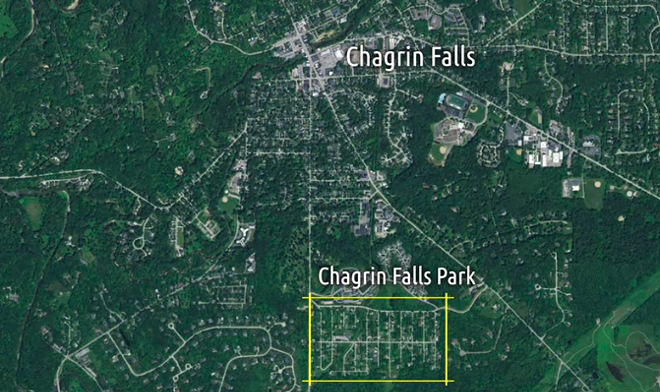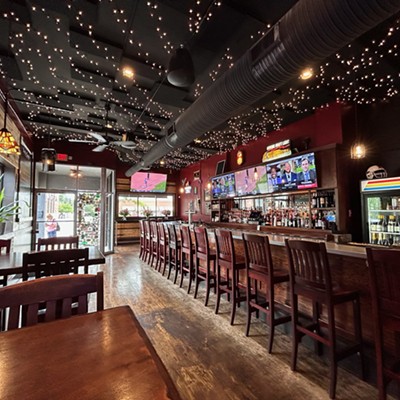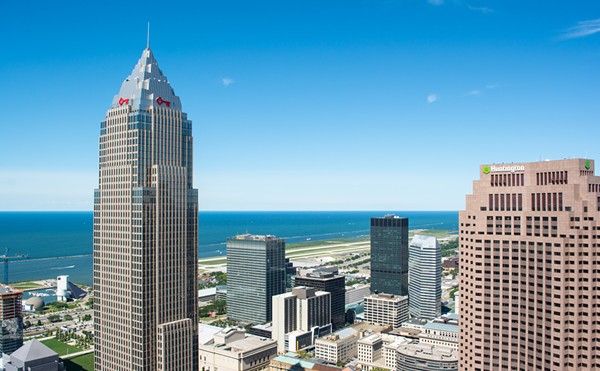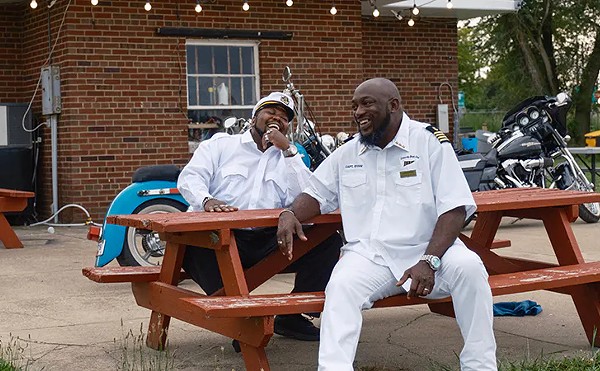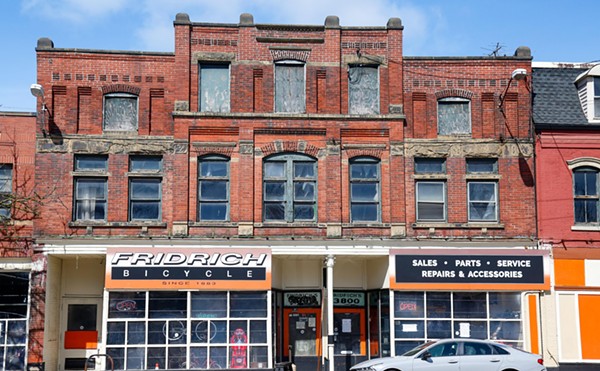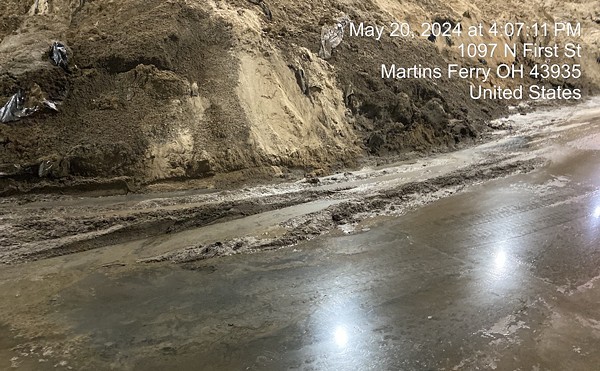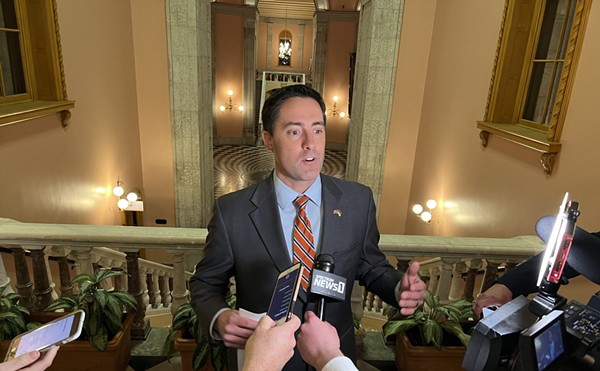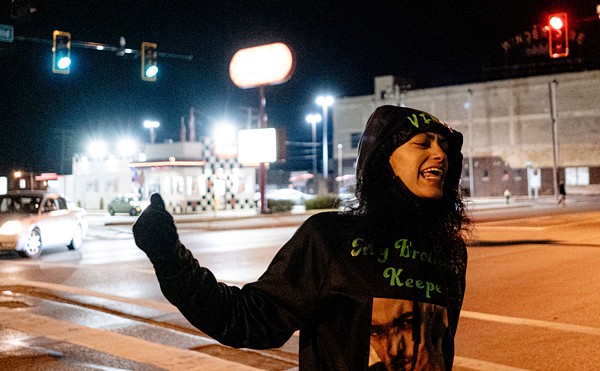Chagrin Falls Park, Black Neighborhood Next to Chagrin Falls, at Heart of Last Week's Protest Controversy
By Shana Black on Tue, Jun 9, 2020 at 10:23 am
[
{
"name": "Ad - NativeInline - Injected",
"component": "38482495",
"insertPoint": "3",
"requiredCountToDisplay": "5"
},{
"name": "Real 1 Player (r2) - Inline",
"component": "38482494",
"insertPoint": "2/3",
"requiredCountToDisplay": "9"
}
]
Last week, the quaint suburban village of Chagrin Falls made the news for a Black Lives Matter rally organized by a local 16-year-old. The event was canceled due to community backlash and fears of riots, but approximately 100 people still came out to support the effort on June 2nd. Two days later, a larger Black Lives Matters rally was organized by a different group of people. Businesses boarded up their windows in advance of the first rally, but according to community members in attendance, both rallies were peaceful.
Former Solon Mayor Bob Paulson wrote in cleveland.com that it was “unfair” to beat up on Chagrin Falls for its “white mindset” and “merchant hysteria.” He defended businesses for taking precautions after a protest in downtown Cleveland turned violent the previous Saturday after escalations by the police. Others noted on social media that Chagrin Falls, which is 97 percent white, has a unique history with race. Many pointed out that a separate, predominantly black, community called Chagrin Falls Park exists just down the road on the other side of the Cuyahoga County border, in Bainbridge Township.
Some wish that Chagrin Falls Park didn’t exist. Others see it as a blight on picturesque Chagrin Falls. But most don’t know the stories of opportunity and pride that came from that community in the early 1900s. Those stories are worth revisiting in light of nationwide protests for racial justice.
Early residents began arriving in Chagrin Falls Park during the Great Migration in the 1910s and 1920s. Many came from the South and were looking for a quiet piece of land away from the hustle and bustle of Cleveland’s industrialized urban core. For African-Americans coming from the South that were used to being spread out and having the ability to grow their own crops and keep livestock, Chagrin Falls Park was ideal.
Initially, the 81 acres of land that comprised the Park were advertised by the owner of Jewish World, a Yiddish-language magazine, to be sold in 20 by 100 foot lots, with no building restrictions. The land had no sewers, electricity or paved roads, which made the lots a hard sell for the magazine’s readers. Needless to say, many of the lots went unsold. Real estate agents Grover and Florence Brow eventually bought the remaining lots and began selling them to the skilled-labor African-American workers in Cleveland.
The duo ran ads in Black newspapers during the 1910s and 1920. Ads played up the idea of an all-Black suburb using pro-Black language uplifting the names of Booker T. Washington and Frederick Douglass in attempts to lure people out of the city.
Initially, plots were sold for $25, which was obtainable on a Black laborer’s wage. During the Great Depression, plots could be purchased for as low as $2 each. Many of the white residents of the Park fell delinquent on their taxes, leaving homes vacant and available for rent or purchase by Blacks. There was also trolley service that ran from Cleveland to Chagrin Falls until 1924, which made it easy for men to get to the city for work.
Early residents of Chagrin Falls Park supplemented their incomes in various ways. Rent parties, running numbers, and rum-running were all prevalent. Residents would rent rooms in their homes and sell the food, livestock, and poultry grown on their land to get them through the tough economic times and job losses of the Great Depression. The lure of owning a newly built home also appealed to Blacks, although they often had to use cheaper lumber and materials due to making less money than their white counterparts.
Chagrin Falls Park continued to grow. According to the 1930 census, there were 57 African American residents; in 1940, there were 200; and by 1950, 650 Black people called Chagrin Falls Park home. The Park peaked in 1960 with 900 residents before the population dwindled.
Chagrin Falls Park was a community of what we would now call Black Excellence. Black men and women were active in their community. In a time where many women had not entered the workforce, Black women worked as domestics in the home of the white Chagrin Falls residents to supplement their husbands’ pay in factories and service departments in the City of Cleveland. They opened bars, shops, and provided child care for other residents to help make ends meet. Park women were active in their community, serving in the Geauga County Negro Republican Party, fundraising, and driving voters to the polls. Residents worked with the Cleveland’s NAACP to advocate for desegregation of Park Elementary School, and they sponsored the local baseball club and served as volunteer firefighters for their community.
The residents of Chagrin Falls Park were self-sufficient. They relied on their own resources and grit to support their community and neighbors. When the trolley stopped going out to Chagrin Falls, the men would carpool into Cleveland for work. They established churches and a Park baseball team to play other Black teams in Northeast Ohio. They hosted an annual Fish Fry as a community fundraiser that brought Black Clevelanders out to their dirt roads where they “walked in that dust like it was gold dust.”
Unfortunately, the residents of Chagrin Falls Park were not exempt from racism. Pay disparities combined with fear of unaffordable taxes left residents to advocate for services like garbage pick-up and water into the 1980s. Many homes often caught fire due to cheap materials and reliance on lanterns and fires instead of utilities.
After World War II, social security and Blacks’ acceptance into labor unions opened up more options for homeownership for both Blacks and whites. As the Civil Rights movement continued, Blacks began to pursue a more affluent lifestyle and began to settle in Cleveland’s first-ring suburbs and away from rural suburbs like Chagrin Falls Park. The Federal Housing Administration’s insistence on racial segregation, redlining, and a series of zoning laws also pushed Blacks to settle in certain parts of Cleveland and made living in the Park undesirable for some and no longer an option for others.
The Park neighborhood still exists today. Nestled off of South Franklin Street near Chagrin Falls Cemetery in Bainbridge, older residents of the community make sure to tell their younger neighbors about the history of the houses and where the Juke Joints used to be. And despite being a neighborhood adjacent to the Village of Chagrin Falls, the children that live in the Park do not attend Chagrin Falls Schools. Instead, they attend neighboring Kenston schools. Chase Tuller, the 16-year-old who organized the Black Lives Matter protest last week, is Kenston’s sophomore class president.
***
Sign up for Scene's weekly newsletters to get the latest on Cleveland news, things to do and places to eat delivered right to your inbox.
Former Solon Mayor Bob Paulson wrote in cleveland.com that it was “unfair” to beat up on Chagrin Falls for its “white mindset” and “merchant hysteria.” He defended businesses for taking precautions after a protest in downtown Cleveland turned violent the previous Saturday after escalations by the police. Others noted on social media that Chagrin Falls, which is 97 percent white, has a unique history with race. Many pointed out that a separate, predominantly black, community called Chagrin Falls Park exists just down the road on the other side of the Cuyahoga County border, in Bainbridge Township.
Some wish that Chagrin Falls Park didn’t exist. Others see it as a blight on picturesque Chagrin Falls. But most don’t know the stories of opportunity and pride that came from that community in the early 1900s. Those stories are worth revisiting in light of nationwide protests for racial justice.
Early residents began arriving in Chagrin Falls Park during the Great Migration in the 1910s and 1920s. Many came from the South and were looking for a quiet piece of land away from the hustle and bustle of Cleveland’s industrialized urban core. For African-Americans coming from the South that were used to being spread out and having the ability to grow their own crops and keep livestock, Chagrin Falls Park was ideal.
Initially, the 81 acres of land that comprised the Park were advertised by the owner of Jewish World, a Yiddish-language magazine, to be sold in 20 by 100 foot lots, with no building restrictions. The land had no sewers, electricity or paved roads, which made the lots a hard sell for the magazine’s readers. Needless to say, many of the lots went unsold. Real estate agents Grover and Florence Brow eventually bought the remaining lots and began selling them to the skilled-labor African-American workers in Cleveland.
The duo ran ads in Black newspapers during the 1910s and 1920. Ads played up the idea of an all-Black suburb using pro-Black language uplifting the names of Booker T. Washington and Frederick Douglass in attempts to lure people out of the city.
Initially, plots were sold for $25, which was obtainable on a Black laborer’s wage. During the Great Depression, plots could be purchased for as low as $2 each. Many of the white residents of the Park fell delinquent on their taxes, leaving homes vacant and available for rent or purchase by Blacks. There was also trolley service that ran from Cleveland to Chagrin Falls until 1924, which made it easy for men to get to the city for work.
Early residents of Chagrin Falls Park supplemented their incomes in various ways. Rent parties, running numbers, and rum-running were all prevalent. Residents would rent rooms in their homes and sell the food, livestock, and poultry grown on their land to get them through the tough economic times and job losses of the Great Depression. The lure of owning a newly built home also appealed to Blacks, although they often had to use cheaper lumber and materials due to making less money than their white counterparts.
Chagrin Falls Park continued to grow. According to the 1930 census, there were 57 African American residents; in 1940, there were 200; and by 1950, 650 Black people called Chagrin Falls Park home. The Park peaked in 1960 with 900 residents before the population dwindled.
Chagrin Falls Park was a community of what we would now call Black Excellence. Black men and women were active in their community. In a time where many women had not entered the workforce, Black women worked as domestics in the home of the white Chagrin Falls residents to supplement their husbands’ pay in factories and service departments in the City of Cleveland. They opened bars, shops, and provided child care for other residents to help make ends meet. Park women were active in their community, serving in the Geauga County Negro Republican Party, fundraising, and driving voters to the polls. Residents worked with the Cleveland’s NAACP to advocate for desegregation of Park Elementary School, and they sponsored the local baseball club and served as volunteer firefighters for their community.
The residents of Chagrin Falls Park were self-sufficient. They relied on their own resources and grit to support their community and neighbors. When the trolley stopped going out to Chagrin Falls, the men would carpool into Cleveland for work. They established churches and a Park baseball team to play other Black teams in Northeast Ohio. They hosted an annual Fish Fry as a community fundraiser that brought Black Clevelanders out to their dirt roads where they “walked in that dust like it was gold dust.”
Unfortunately, the residents of Chagrin Falls Park were not exempt from racism. Pay disparities combined with fear of unaffordable taxes left residents to advocate for services like garbage pick-up and water into the 1980s. Many homes often caught fire due to cheap materials and reliance on lanterns and fires instead of utilities.
After World War II, social security and Blacks’ acceptance into labor unions opened up more options for homeownership for both Blacks and whites. As the Civil Rights movement continued, Blacks began to pursue a more affluent lifestyle and began to settle in Cleveland’s first-ring suburbs and away from rural suburbs like Chagrin Falls Park. The Federal Housing Administration’s insistence on racial segregation, redlining, and a series of zoning laws also pushed Blacks to settle in certain parts of Cleveland and made living in the Park undesirable for some and no longer an option for others.
The Park neighborhood still exists today. Nestled off of South Franklin Street near Chagrin Falls Cemetery in Bainbridge, older residents of the community make sure to tell their younger neighbors about the history of the houses and where the Juke Joints used to be. And despite being a neighborhood adjacent to the Village of Chagrin Falls, the children that live in the Park do not attend Chagrin Falls Schools. Instead, they attend neighboring Kenston schools. Chase Tuller, the 16-year-old who organized the Black Lives Matter protest last week, is Kenston’s sophomore class president.
***
Sign up for Scene's weekly newsletters to get the latest on Cleveland news, things to do and places to eat delivered right to your inbox.
SCENE Supporters make it possible to tell the Cleveland stories you won’t find elsewhere.
Become a supporter today.
Scroll to read more Cleveland News articles
Newsletters
Join Cleveland Scene Newsletters
Subscribe now to get the latest news delivered right to your inbox.

